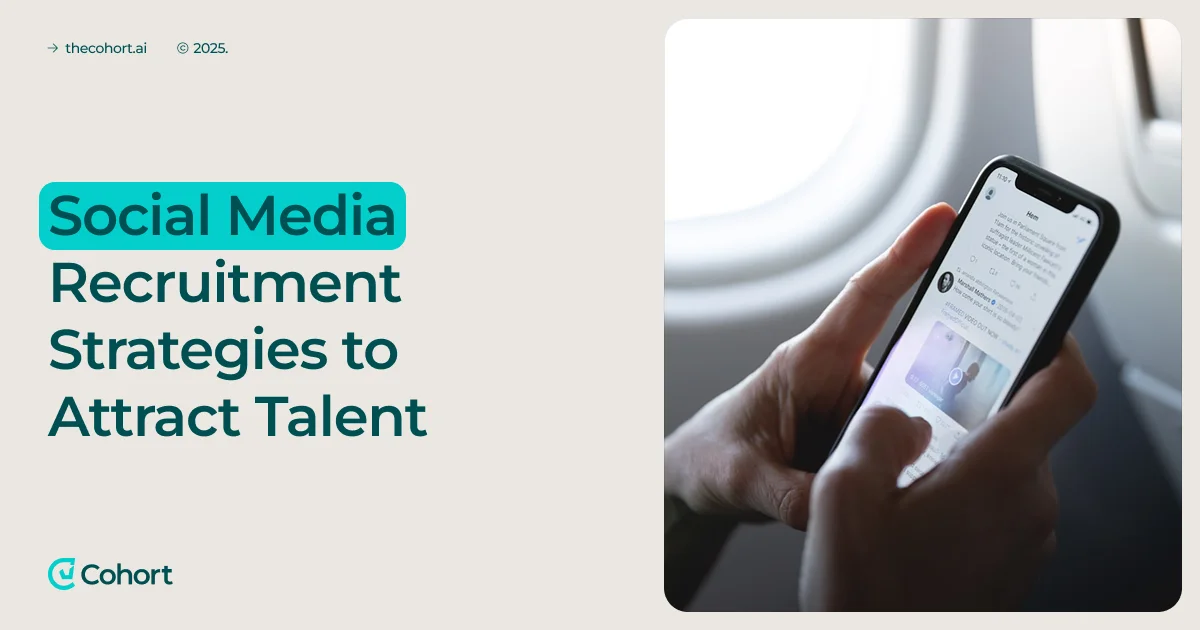Did you know that over 84% of organizations now use social media to recruit new talent? Yet even with this widespread use, many still struggle to stand out and connect with the right people.
Simply posting job ads isn’t enough to reach today’s passive job seekers, who make up a large part of the talent pool and rarely apply directly.
That’s why building visibility, engagement, and a genuine employer brand can make all the difference in attracting the right candidates.
To help you do just that, we’ve put together 6 proven social media recruitment strategies to find and hire top talent!
Key Takeaways
- Social media expands reach and attracts quality candidates
With over 5.4 billion users worldwide, social platforms give recruiters access to a massive talent pool. Nearly 79% of job seekers use social media in their job search, making it essential for visibility and reach.
- Showcasing company culture builds trust and appeal
Candidates are drawn to authentic brands. Sharing real stories, employee highlights, and behind-the-scenes content helps potential hires connect emotionally and see what it’s like to work for you.
- Employee advocacy drives organic recruiting success
Encouraging employees to share openings or personal experiences multiplies your reach. Referrals from trusted networks consistently deliver high-quality hires while boosting your employer reputation.
- Using data and analytics improves recruiting ROI
Tracking engagement, click-throughs, and conversion rates helps identify which platforms and content types perform best. With ongoing optimization, you can attract stronger candidates faster and at lower cost.
- Cohort AI makes social recruiting faster and smarter
While social media brings candidates in, Cohort AI helps you find and engage the right ones. By combining AI-powered sourcing, personalized outreach, and intelligent matching, it reduces time-to-hire by up to 40% and ensures every recommendation fits your team perfectly.
Why use social media for recruitment?
Social media has transformed recruitment, making it easier for companies to connect with potential candidates and share their culture in engaging ways. Here are a few reasons why social media is such an effective recruitment tool:
🟢 Wider reach and targeted audience
With over 5.4 billion people worldwide actively using social media in 2025, employers have access to an immense and diverse talent pool.
Since about 79% of job seekers use social platforms when searching for jobs, recruiters can effectively connect with candidates where they already spend their time.
🟢 Engaging passive candidates
Social media enables employers to reach professionals who aren’t actively job hunting but remain open to new opportunities. Approximately 70% of job seekers are passive candidates, and around 82% of employers utilize social channels specifically to engage this valuable group.
🟢 Showcasing employer brand and culture
Through posts, videos, and stories, companies can authentically highlight their culture, values, and work environment. Approximately 88% of candidates say a company’s brand influences their decision to apply, making a strong social media presence a key recruitment asset.
🟢 Cost-effective recruiting
Social media recruiting is an affordable alternative to traditional hiring methods. Posting job openings or sharing content on platforms like LinkedIn, Facebook, and X (Twitter) costs little to nothing, allowing companies to reach more candidates without large advertising expenses.
🟢 Faster and more interactive hiring
Social media also streamlines the hiring process by enabling instant communication and engagement. Recruiters can quickly share updates, respond to questions, and even pre-screen candidates by reviewing their profiles.
This immediacy helps reduce candidate frustration, as poor communication and lengthy hiring processes cause about 60% of candidates to drop out or lose interest in applying.
Attract more candidates: 6 best social media recruitment strategies
Using social media effectively for recruitment requires more than just posting job ads online. It involves a mix of marketing savvy, engagement tactics, and data-driven planning. Here are eight proven strategies to boost your social media recruitment in 2025:
1. Optimize your company profiles for recruiting
Your company’s social media profiles often create the first impression for potential candidates, so it’s important that they reflect your brand at its best.
An up-to-date, well-branded online presence shows professionalism and helps position your organization as an appealing place to work.
✅ How to make it work
- Keep profiles current: Regularly update company pages on LinkedIn, Facebook, Instagram, and other platforms with accurate information, recent achievements, and open roles.
- Show who you are: Highlight your mission, values, and workplace culture through posts, photos, and employee stories.
- Use consistent branding: Align visuals, tone, and messaging across all platforms to strengthen recognition and trust.
- Promote opportunities: Create or maintain a dedicated careers section or “Jobs” tab where possible, linking directly to current openings or your talent community.
🧠 Example: Salesforce
On LinkedIn, Salesforce effectively utilizes its “Life” section, a dedicated space that showcases employee stories, company culture, and workplace values. Here, candidates can explore what it’s like to work at Salesforce through real voices and experiences, not just job descriptions.
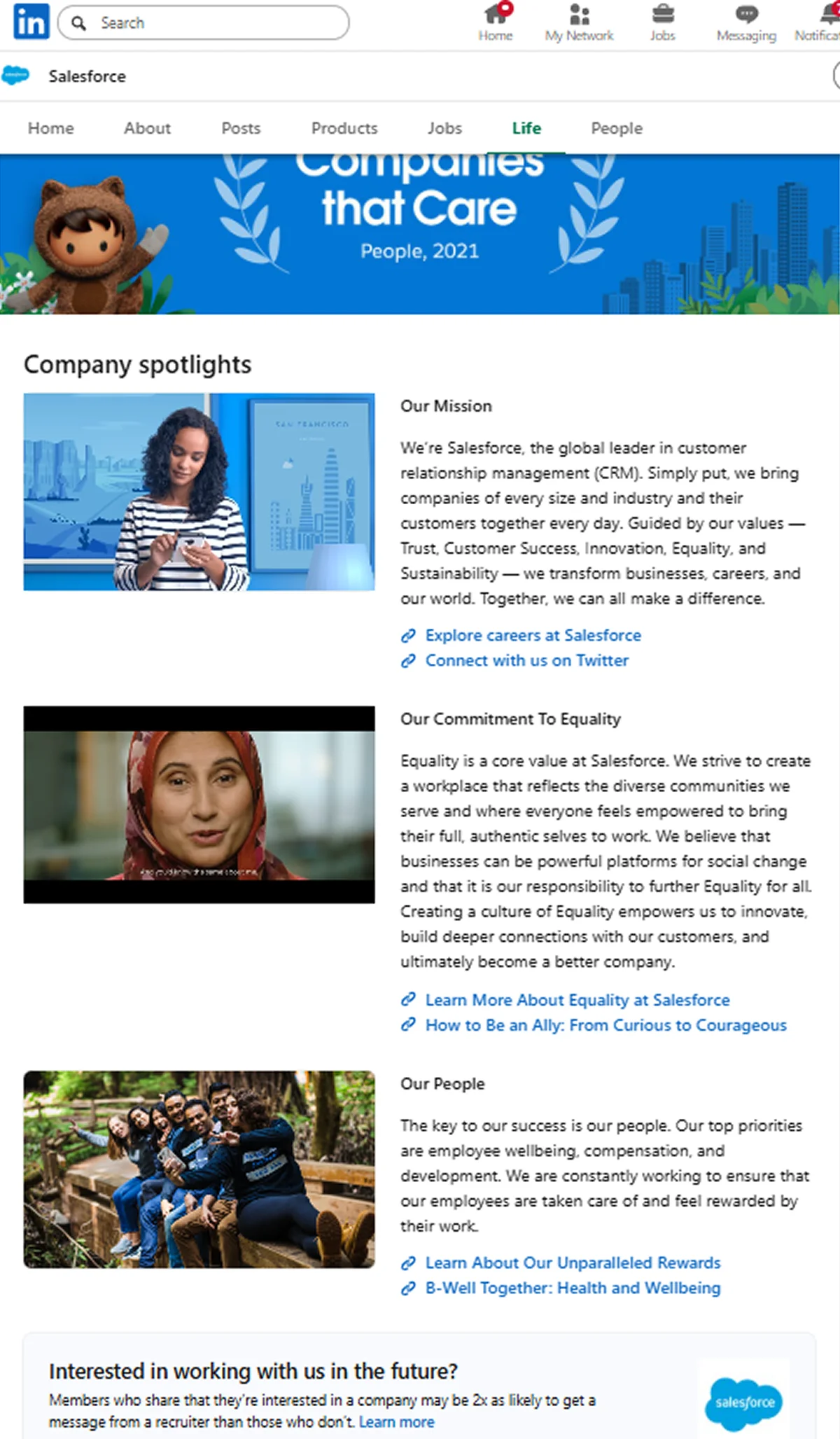
Additionally, instead of relying solely on job postings, they launched dedicated “Salesforce Jobs” channels across LinkedIn, Instagram, and Facebook.
Through these platforms, Salesforce highlights behind-the-scenes moments, team achievements, and career growth opportunities, helping potential hires connect emotionally with the brand.
2. Choose the right platforms for your target talent
Not all social networks are equally effective for recruitment. To attract the right candidates, identify your target audience, including their age, profession, and interests, and focus your efforts on the platforms where they already spend their time.
For example:
- LinkedIn is the top platform for professional and experienced talent, with over 90% of recruiters actively searching for candidates there.
- Instagram, TikTok, and YouTube are ideal for attracting younger or creative talent, as they allow you to showcase your company culture and work environment through visually engaging content.
- Facebook remains a valuable recruiting channel, reaching a broad demographic with 2 billion daily active users and 60% of recruiting managers using it to source talent.
✅ How to make it work
🟡 Map your target personas: Define who you’re trying to reach (e.g., software engineers, designers, entry-level marketers) and where they spend their time online.
🟡 Play to each platform’s strengths:
- LinkedIn: Share job postings, thought leadership, and industry updates.
- TikTok/Instagram: Post behind-the-scenes videos, team stories, and day-in-the-life clips to highlight your culture.
- Facebook: Use groups and community pages to tap into local or niche audiences.
- X (formerly Twitter): Share quick updates, event news, and company wins to stay visible.
🟡 Use data to guide your efforts: Track engagement and applicant sources with tools like Google Analytics and LinkedIn Talent Insights to see which platforms deliver the strongest candidates and highest-quality applications.
🟡 Stay consistent with your brand: Maintain your company’s voice and visual identity across all platforms, even if the content format varies.
3. Engage and network with potential candidates
The best part of social media is that it allows you to build genuine relationships with your audience. It creates opportunities to humanize your brand, foster trust, and connect with both active and passive candidates
✅ How to make it work
- Respond and interact: Reply to comments on your posts, answer questions about company culture or open roles, and thank people for engaging with your content.
- Join relevant communities: Participate in LinkedIn Groups or industry-specific forums, and join X (Twitter) chats or other discussions centered around career or professional development topics.
- Offer value, not just promotion: Share advice, insights, or thought leadership content to position your company as approachable and authentic, not just a recruiter looking to fill roles.

- Personalize outreach: When you find promising talent on LinkedIn or in professional Facebook groups, send a personalized connection request or message that references their experience and introduces potential opportunities.
- Leverage social listening tools: Track mentions of your company or key industry terms to identify and engage with individuals who are already showing interest or curiosity about your brand.
- Be consistently responsive: Maintain an active presence and follow up thoughtfully, as these authentic interactions leave a lasting, positive impression and make your organization top of mind when candidates are ready to make a move.
4. Encourage employee advocacy and referrals
Did you know that 65% of people are open to hearing about a new job through someone in their social network? That’s why empowering your employees to be brand advocates can transform your recruiting reach.
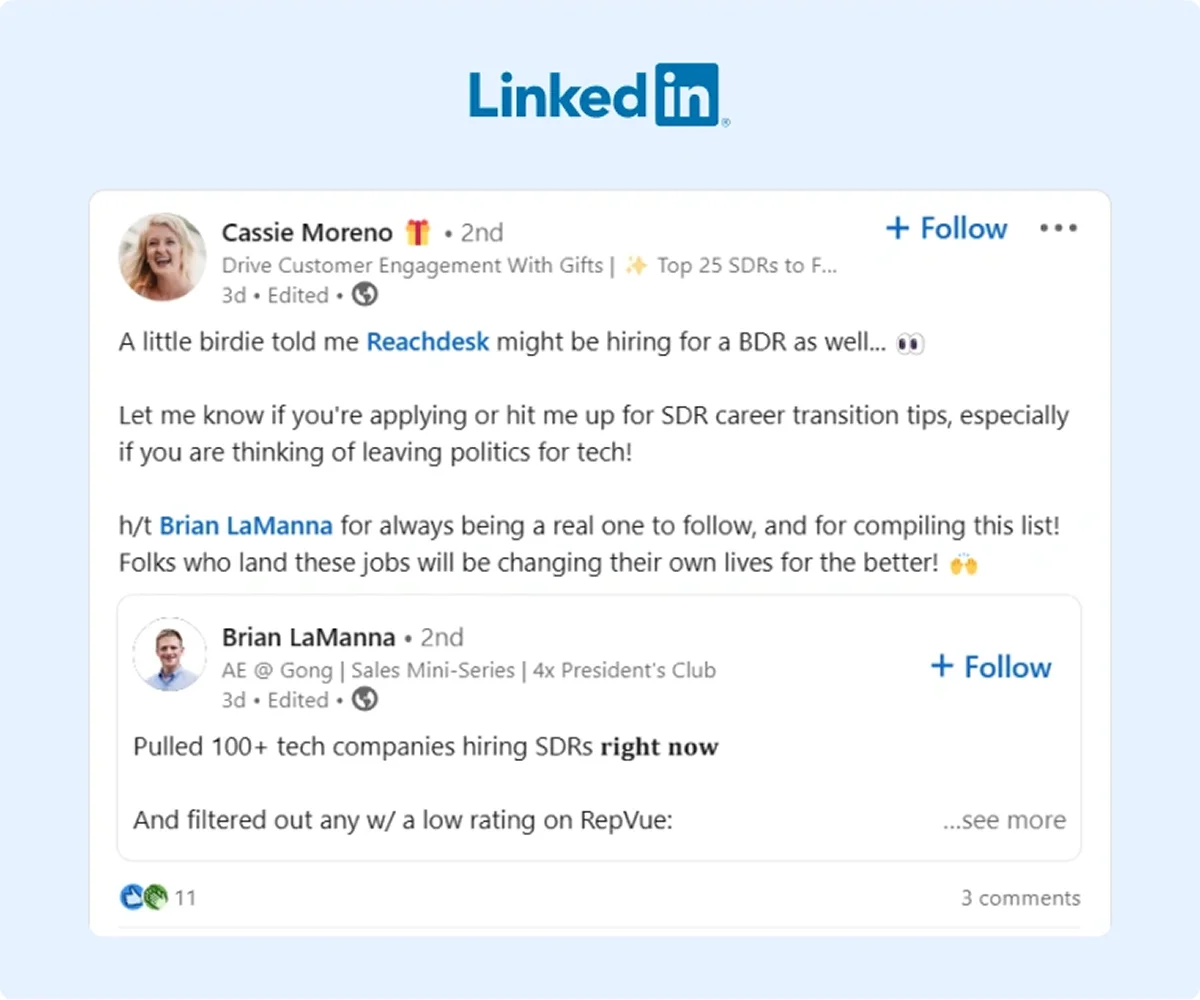
When team members share their experiences, celebrate wins, or post job openings, it builds trust and attracts talent more effectively than traditional ads ever could.
✅ How to make it work
- Launch an advocacy program: Provide pre-approved templates, visuals, and hashtags to make it easy for employees to share company content.
- Encourage authentic storytelling: Inspire team members to share their genuine experiences, from exciting projects to community events.
- Recognize and celebrate: Highlight employee achievements publicly so they feel proud to share those moments with others.
- Reward referrals: Offer clear incentives, such as cash bonuses, for hires that come through employee referrals.
🧠 Example: Salesforce
Salesforce’s global #SalesforceOhana initiative has become one of the world’s most successful employee advocacy programs.
Rooted in the Hawaiian concept of Ohana (meaning family), it fosters trust, equality, and collaboration, inspiring employees to share authentic stories that reflect Salesforce’s culture and mission.
The results? Employee referrals now generate 52% of all new hires. Here is what they did:
- Employees receive ready-to-share templates, visuals, and messaging guides to post about company culture, volunteering, and innovation on their personal networks.
- Top employee advocates are celebrated regularly for their contributions to amplifying Salesforce’s brand and values.
- Employees are rewarded for successful referrals, often with incentives such as cash bonuses (e.g., $2,000 per hire).
- Referral incentives are complemented by recognition programs, keeping employees inspired to participate.
5. Leverage paid advertising and targeted job posts
Paid social media advertising is one of the most efficient ways to expand your recruiting reach and attract high-quality candidates.
Major platforms like LinkedIn, Facebook, and Instagram allow you to promote job openings or boost recruitment content to a specific audience, ensuring your message reaches the right professionals instead of getting buried in algorithm feeds.

✅ How to make it work
- Start with small, strategic budgets: Even modest ad spends can deliver strong results when your targeting is precise.
For example, Facebook ads can reach candidates based on location, industry, education level, or interests, while LinkedIn offers advanced filters for job title, skills, and company.
- Use platform-specific job tools: Take advantage of LinkedIn Sponsored Jobs or Facebook’s Jobs feature to increase visibility for open roles and drive qualified applications.
- Target with intention: Define your ideal candidate persona (skills, experience, and geography) and use the platform’s audience filters to reach them directly.
- Track and optimize: Monitor ad performance, clicks, applications, and engagement, and adjust creative, copy, or targeting for better ROI.
💡 Pro tip
Sometimes, even with the best targeting, you can pour thousands into ads and still not see the results you hoped for, especially if the right candidates just aren’t actively looking. That’s where automation can change the game.
Tools like Cohort AI’s Sally the Sourcer act as your always-on talent scout, scanning millions of profiles across LinkedIn, GitHub, and proprietary datasets to uncover top-tier candidates who perfectly match your requirements.
Sally never sleeps, so while your ads work on visibility, she keeps your pipeline full of unicorn-caliber talent, delivering three spot-on candidates in just a few days.
6. Leverage analytics to refine your social recruiting strategy
Social recruiting works best when it’s treated as an ongoing experiment. Using analytics from each platform and your applicant tracking system (ATS) helps you see what resonates with your audience and where to fine-tune your approach.
✅ How to make it work
- Track key metrics: Monitor engagement (likes, shares, comments), click-through rates, follower growth, and hires attributed to social posts.
Set up a simple dashboard in a spreadsheet or your ATS to log these numbers regularly, allowing you to spot patterns and measure progress over time.
- Identify top-performing content: Analyze which posts attract the most attention and interaction.
Compare different formats (videos, images, and text) to determine what drives the strongest response, and focus your efforts on the types of content that consistently perform best.
- Use audience insights: Review platform analytics to understand who’s seeing and engaging with your posts, including job roles, locations, and demographics. Adjust your targeting if you’re not reaching the right audience by refining hashtags, keywords, or audience filters.
- Test and adapt: Experiment with variations in posting times, hashtags, and messaging to see which combinations generate better reach and applications.
For example, you might find that posting on LinkedIn early in the week (Tuesday to Thursday mornings) leads to higher engagement, while late-afternoon posts perform better on Instagram.
- Close the feedback loop: Use ATS data to identify where applicants are finding your job postings and which channels lead to actual hires.
You can also include a simple “How did you hear about us?” question in your applications to capture additional insights.
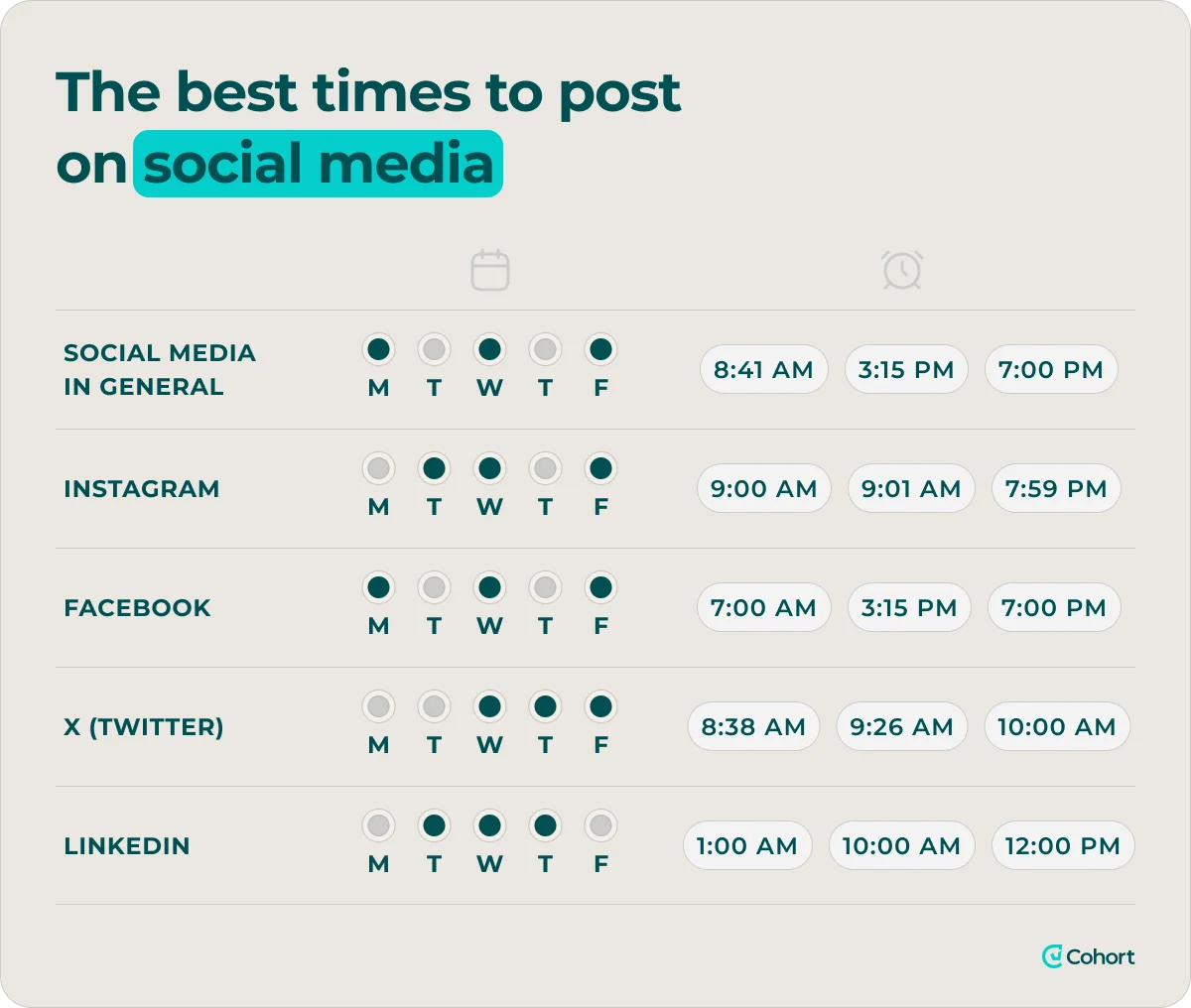
Take your social recruiting further with Cohort AI
Now that you know the best social media recruitment strategies, it’s time to take your hiring efforts even further. Social media helps you reach and attract a wide pool of potential candidates, but finding and selecting the right ones still takes time and effort.
That’s where Cohort AI comes in.
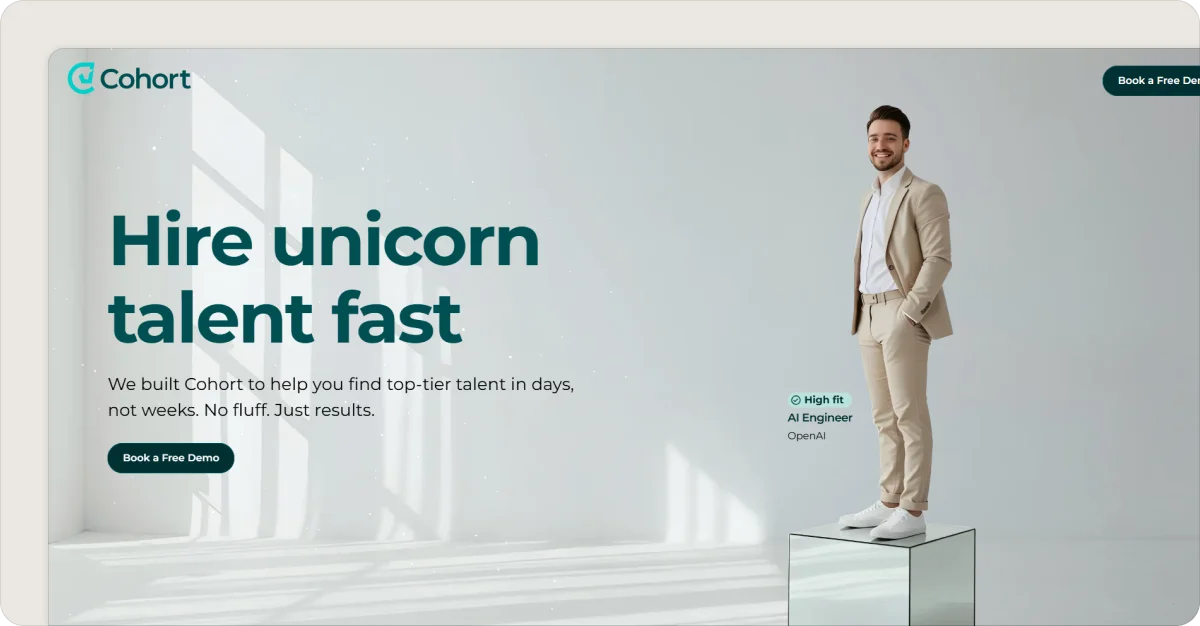
By integrating generative AI into everyday recruiting workflows, from sourcing and assessment to personalized engagement and matching, Cohort AI helps hiring teams recruit smarter, communicate more effectively, and scale their efforts without increasing headcount.
In just a few days, it can identify the top three candidates for any technical role, while Talent Architects fine-tune the search to ensure every recommendation is the right fit, cutting time-to-hire by 40%.
How Cohort AI helps you:
🟢 Smarter talent sourcing – Discover high-potential candidates by focusing on real skills and achievements, not just what’s on a résumé.
🟢 Simplified assessments – Conduct on-demand, role-specific interviews scored against clear success criteria for fair, consistent evaluations.
🟢 Personalized outreach – Send AI-tailored messages that reflect your brand voice and attract top talent.
🟢 Stronger engagement – Automate follow-ups and FAQs to keep candidates informed and reduce drop-offs.
🟢 Intelligent matching – Match candidates to roles based on skills, behaviors, and working styles, understanding how they work, not just where they’ve worked.
Book a demo today to see how Cohort AI can help you make your social media recruiting more targeted, efficient, and consistent!



